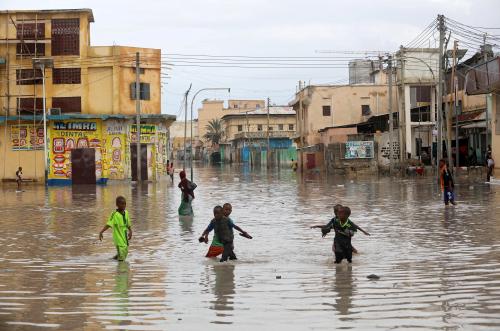On January 8, the Africa Growth Initiative at Brookings released a special edition of its annual Foresight Africa publication. The report highlights the continent’s accomplishments in past years and focuses on six priorities for the upcoming decade, 2020-2030. The fourth chapter, Combating climate change: An urgent call for comprehensive global and local action, argues that comprehensive global and local action is necessary for combating the severe threat that climate change poses to Africa specifically and the world more broadly.
In his essay, Ahmadou Aly Mbaye, nonresident senior fellow at Brookings, argues that the threat of climate change is most imminent on Africa’s coastlines. Africa’s coastal areas tend to be more densely populated due to the economic opportunities there, and populations in these areas are projected to rise at an annual rate of 3.3 percent between 2000-2030, more than double the world average. Rising sea levels—which may increase by up to 100 cm by 2100—will increase the vulnerability of populations living in these low-elevation coastal zones (LECZs). As Figure 4.2 shows, millions of Africans will live in urban and non-urban LECZs by 2030. In countries like Senegal, Benin, and Liberia, large portions of the population—41 percent, 35 percent, and 29 percent, respectively—will be particularly impacted by rising sea levels.
Rising sea levels have a variety of harmful effects in LECZs: They can decrease food production, limit access to clean water, increase the prevalence of catastrophic storms and flooding, and spread acidification. In fact, Mbaye writes that a substantially increased sea surface temperature of 1° C will lead to an increase in violent cyclone activity and storm surges on coastlines. Mangroves, which offer an effective buffer against storm surges, can be damaged by increases in ocean temperature that raise the salinity of inland water, limiting countries’ natural defenses against storms. Increased salinity of inland water also decreases the availability of drinking and irrigation water, and has negative impacts on agriculture and freshwater fishing, further increasing the vulnerability of those living in LECZs.
Mbaye states that adaptation will be paramount for withstanding the effects of climate change on LECZs; without adaptation, the annual costs related to flooding alone could range between $5 billion and $9 billion. Crucial strategies include infrastructure construction and maintenance, beach nourishment, and diversification away from activities vulnerable to climate change. As costs for adequate adaptation measures exceed the resources currently dedicated to these strategies in Africa, scaling up and improving the consistency of this financing will be critical for mitigating the effects of climate change.
The Brookings Institution is committed to quality, independence, and impact.
We are supported by a diverse array of funders. In line with our values and policies, each Brookings publication represents the sole views of its author(s).







Commentary
Figure of the week: Climate change and low-elevation coastal zones in Africa
February 20, 2020